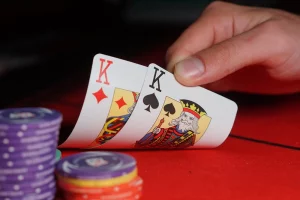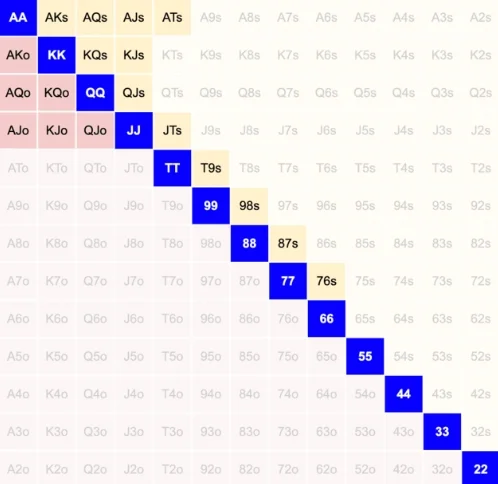What is a Gap Concept in Poker
The concept of the “gap” is an essential part of poker strategy that all professional poker players adhere to. This theory, attributed to the famous poker writer and theorist David Sklansky, sheds light on an aspect of poker dynamics that affects decision making at the table. Gap theory looks at the disparity between the strength of the hand with which a player decides to raise and the strength of the hand needed to call that raise.

At its core, the gap concept emphasizes the idea that a player needs a stronger hand to call a raise than to make it himself. This principle is based on the risk associated with each action; initiating a raise inherently carries less risk than a call because the raiser has the advantage of aggression and the ability to control the outcome of the hand. Consequently, the player making the call must compensate for this disadvantage by having a higher value hand capable of countering the perceived strength of the raiser’s actions.
The application and value of the gap concept is greatly influenced by the player’s position at the table and the size of the bets. Position plays a key role in determining the perceived strength of a raise and thus the strength needed to call. Raising from an early position implies a stronger range, given the player’s willingness to enter the pot despite the number of players who have yet to act. Conversely, a raise from a later position may be viewed with more skepticism, as players in these positions have a wider range and often take a more aggressive stance.
The size of the bet further complicates the gap concept, as larger raises imply greater strength and therefore require a call with stronger hands. Smaller raises, on the other hand, may be perceived as less indicative of a strong hand, which somewhat narrows the gap between the required strength of the raiser’s hand and the call. However, the fundamental premise remains the same: to justify participation in a raiser, the caller must have a hand of significant strength.
How the Gap Concept Works in Poker

The gap concept is a theory presented by poker writer David Sklansky. At its core, this concept articulates a fundamental mismatch – the gap between the strength of the hand with which a player should raise and the hand with which the same player should call a raise. This gap, explains the increased caution and the requirement of a stronger hand necessary when considering to call a raise, rather than initiating one.
Central to the understanding of the gap concept is the recognition of the key role of position and bet size dynamics in shaping decision-making processes. The concept becomes particularly relevant in scenarios where the sequence of bets and the positions of players on the table dramatically affect the perceived strength of hands.
Consider a situation where a player in an early position, say under the gun, decides to raise. This action implicitly implies a strong hand, given that the player is well aware of several subsequent players who have yet to act, any of whom may possess a competing hand. In this context, the gap concept suggests a cautious approach for players contemplating a call. For example, if our player has a strong pair such as pocket queens, this hand gains significant competitive leverage against the range of the original raiser. The strength of pocket queens in this case justifies a call or even a re-raise, based on the assumption that the raiser in early position has a hand with a strong range.
Conversely, the gap concept also advises restraint in certain circumstances. If, in another scenario, our player finds himself with a marginal hand such as pocket 8s, the rules of the gap concept may dictate a fold rather than a call of the raiser. Despite the relative strength of pocket 8s in isolation, the increased stakes and implied strength of a raise in early position raise the risk above the potential reward, thereby inclining the player to fold.
The effectiveness of the gap concept depends on the player’s ability to evaluate and adapt to position dynamics, betting patterns, and the implied ranges of opponents. It emphasizes the need for a stronger hand to call a raise than that required to make that raise on its own, highlighting the strategic gulf that players must bridge shrewdly.
My Thoughts on the Gap Concept
The concept of gaps, as presented by David Sklansky, offers an in-depth strategic understanding of the intricacies of the poker decision-making process. It emphasizes the importance of hand strength, position and betting dynamics in developing a successful poker strategy. The concept emphasizes the fundamental principle that a stronger hand should call a raise than make a bet, emphasizing the strategic caution required in response to the actions of preceding players.
The positives of the gap concept are manifold. Understanding the full strengths of the gap gives more options to the player, helping them make better decisions about when to enter the pot, especially against raises from early position. By applying this concept, players can avoid the common pitfalls of overvaluing marginal hands, thereby preserving their chip stacks and improving their overall game strategy. In addition, the concept encourages players to better understand their opponents’ ranges and betting patterns, fostering a more analytical approach to the game.
However, the gap concept is not without its drawbacks. One significant problem is accurately estimating the gap in hand range between different players, which can be a difficult task. Poker is a game of incomplete information, and the ability to accurately determine an opponent’s hand range requires a great deal of experience. In addition, the dynamic nature of poker means that the concept cannot be equally applicable in all situations. Factors such as the propensity of opponents, the texture of the board and the stakes in play can affect the effectiveness of the gap concept. In addition, in modern poker, where aggressive and loose play is prevalent, especially online, the gap concept can sometimes cause players to over-fold, missing out on potentially profitable situations.
In fact, while the gap concept remains a valuable tool in a player’s strategic arsenal, it should not be blindly believed and followed. Successful poker strategy requires a balance between adhering to established principles and adapting to the variability of each game.

